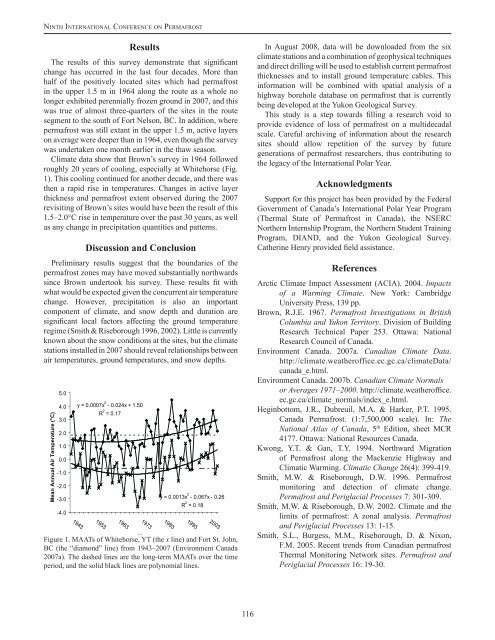Ninth International Conference on Permafrost ... - IARC Research
Ninth International Conference on Permafrost ... - IARC Research
Ninth International Conference on Permafrost ... - IARC Research
Create successful ePaper yourself
Turn your PDF publications into a flip-book with our unique Google optimized e-Paper software.
Ni n t h In t e r n at i o n a l Co n f e r e n c e o n Pe r m a f r o s tResultsThe results of this survey dem<strong>on</strong>strate that significantchange has occurred in the last four decades. More thanhalf of the positively located sites which had permafrostin the upper 1.5 m in 1964 al<strong>on</strong>g the route as a whole nol<strong>on</strong>ger exhibited perennially frozen ground in 2007, and thiswas true of almost three-quarters of the sites in the routesegment to the south of Fort Nels<strong>on</strong>, BC. In additi<strong>on</strong>, wherepermafrost was still extant in the upper 1.5 m, active layers<strong>on</strong> average were deeper than in 1964, even though the surveywas undertaken <strong>on</strong>e m<strong>on</strong>th earlier in the thaw seas<strong>on</strong>.Climate data show that Brown’s survey in 1964 followedroughly 20 years of cooling, especially at Whitehorse (Fig.1). This cooling c<strong>on</strong>tinued for another decade, and there wasthen a rapid rise in temperatures. Changes in active layerthickness and permafrost extent observed during the 2007revisiting of Brown’s sites would have been the result of this1.5–2.0°C rise in temperature over the past 30 years, as wellas any change in precipitati<strong>on</strong> quantities and patterns.Discussi<strong>on</strong> and C<strong>on</strong>clusi<strong>on</strong>Preliminary results suggest that the boundaries of thepermafrost z<strong>on</strong>es may have moved substantially northwardssince Brown undertook his survey. These results fit withwhat would be expected given the c<strong>on</strong>current air temperaturechange. However, precipitati<strong>on</strong> is also an importantcomp<strong>on</strong>ent of climate, and snow depth and durati<strong>on</strong> aresignificant local factors affecting the ground temperatureregime (Smith & Riseborough 1996, 2002). Little is currentlyknown about the snow c<strong>on</strong>diti<strong>on</strong>s at the sites, but the climatestati<strong>on</strong>s installed in 2007 should reveal relati<strong>on</strong>ships betweenair temperatures, ground temperatures, and snow depths.Mean Annual Air Temperature (°C)5.04.03.02.01.00.0-1.0-2.0-3.0-4.01943y = 0.0007x 2 - 0.024x + 1.50R 2 = 0.17195319631973Yeary = 0.0013x 2 - 0.067x - 0.26R 2 = 0.18Figure 1. MAATs of Whitehorse, YT (the x line) and Fort St. John,BC (the “diam<strong>on</strong>d” line) from 1943–2007 (Envir<strong>on</strong>ment Canada2007a). The dashed lines are the l<strong>on</strong>g-term MAATs over the timeperiod, and the solid black lines are polynomial lines.198319932003In August 2008, data will be downloaded from the sixclimate stati<strong>on</strong>s and a combinati<strong>on</strong> of geophysical techniquesand direct drilling will be used to establish current permafrostthicknesses and to install ground temperature cables. Thisinformati<strong>on</strong> will be combined with spatial analysis of ahighway borehole database <strong>on</strong> permafrost that is currentlybeing developed at the Yuk<strong>on</strong> Geological Survey.This study is a step towards filling a research void toprovide evidence of loss of permafrost <strong>on</strong> a multidecadalscale. Careful archiving of informati<strong>on</strong> about the researchsites should allow repetiti<strong>on</strong> of the survey by futuregenerati<strong>on</strong>s of permafrost researchers, thus c<strong>on</strong>tributing tothe legacy of the <str<strong>on</strong>g>Internati<strong>on</strong>al</str<strong>on</strong>g> Polar Year.AcknowledgmentsSupport for this project has been provided by the FederalGovernment of Canada’s <str<strong>on</strong>g>Internati<strong>on</strong>al</str<strong>on</strong>g> Polar Year Program(Thermal State of <strong>Permafrost</strong> in Canada), the NSERCNorthern Internship Program, the Northern Student TrainingProgram, DIAND, and the Yuk<strong>on</strong> Geological Survey.Catherine Henry provided field assistance.ReferencesArctic Climate Impact Assessment (ACIA). 2004. Impactsof a Warming Climate. New York: CambridgeUniversity Press, 139 pp.Brown, R.J.E. 1967. <strong>Permafrost</strong> Investigati<strong>on</strong>s in BritishColumbia and Yuk<strong>on</strong> Territory. Divisi<strong>on</strong> of Building<strong>Research</strong> Technical Paper 253. Ottawa: Nati<strong>on</strong>al<strong>Research</strong> Council of Canada.Envir<strong>on</strong>ment Canada. 2007a. Canadian Climate Data.http://climate.weatheroffice.ec.gc.ca/climateData/canada_e.html.Envir<strong>on</strong>ment Canada. 2007b. Canadian Climate Normalsor Averages 1971–2000. http://climate.weatheroffice.ec.gc.ca/climate_normals/index_e.html.Heginbottom, J.R., Dubreuil, M.A. & Harker, P.T. 1995.Canada <strong>Permafrost</strong>. (1:7,500,000 scale). In: TheNati<strong>on</strong>al Atlas of Canada, 5 th Editi<strong>on</strong>, sheet MCR4177. Ottawa: Nati<strong>on</strong>al Resources Canada.Kw<strong>on</strong>g, Y.T. & Gan, T.Y. 1994. Northward Migrati<strong>on</strong>of <strong>Permafrost</strong> al<strong>on</strong>g the Mackenzie Highway andClimatic Warming. Climatic Change 26(4): 399-419.Smith, M.W. & Riseborough, D.W. 1996. <strong>Permafrost</strong>m<strong>on</strong>itoring and detecti<strong>on</strong> of climate change.<strong>Permafrost</strong> and Periglacial Processes 7: 301-309.Smith, M.W. & Riseborough, D.W. 2002. Climate and thelimits of permafrost: A z<strong>on</strong>al analysis. <strong>Permafrost</strong>and Periglacial Processes 13: 1-15.Smith, S.L., Burgess, M.M., Riseborough, D. & Nix<strong>on</strong>,F.M. 2005. Recent trends from Canadian permafrostThermal M<strong>on</strong>itoring Network sites. <strong>Permafrost</strong> andPeriglacial Processes 16: 19-30.116
















